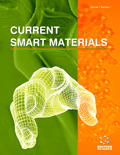[1]
Rydqvist, B.; Purali, N.; Lannergren, J. Visco-elastic properties of the rapidly adapting stretch receptor muscle of the crayfish. Acta Physiol. Scand., 1994, 50(2), 151-159.
[2]
Tendick, F.; Sastry, S.S.; Fearing, R.S.; Cohn, M. Applications of micromechatronics in minimally invasive surgery. In: IEEE/ASME Trans. of Mechatron., 1998, 3(1), 34-42.
[3]
Carrozza, M.; Dario, P.; Jay, L. Micromechatronics in surgery. Trans. Inst. Meas. Contr., 2003, 25(4), 309-327.
[4]
Qasaimeh, M.A.; Stiharu, I.; Dargahi, J. Design and analysis of a micromachined tactile sensor for minimally invasive surgery. In:Advances in Dynamics; Instrumentation and Control: Queretaro, Mexico, 2006, pp. 13-16.
[5]
Qasaimeh, M.A.; Sokhanvar, S.; Dargahi, J.; Kahrizi, M. PVDF-based microfabricated tactile sensor for minimally invasive surgery. J. Microelectromech. Syst., 2009, 18(1), 195-207.
[6]
Tholey, G.; Pillarisetti, A.; Green, W.; Desai, J. Design, development,
and testing of an automated laparoscopic grasper with 3-D
force measurement capability. In: Proceedings of ISMS, Cotin, S.;
Metaxas, D. Eds.; 2004, 3078, 38-48.
[7]
Back, J.; Dasgupta, P.; Seneviratne, L.; Althoefer, K.; Liu, H. Feasibility study-novel optical soft tactile array sensing for minimally invasive surgery. In: IEEE/RSJ International Conference on Intelligent Robots and Systems (IROS), 2015, pp. 1528-1533.
[8]
Ledermann, C.; Alagi, H.; Woern, H.; Schirren, R.; Reiser, S. Biomimetic tactile sensor based on Fiber Bragg Gratings for tumor detection-Prototype and results. In: IEEE International Symposium on Medical Measurements and Applications (MeMeA), 2014, pp. 1-6.
[9]
Okamura, A.M. Haptic feedback in robot-assisted minimally invasive surgery. Curr. Opin. Urol., 2008, 18, 1-6.
[10]
Prattichizzo, D.; Pacchierotti, C.; Cenci, S.; Minamizawa, K.; Rosati, G. Using a fingertip tactile device to substitute kinesthetic feedback in haptic interaction. In: International Conference on Human Haptic Sensing and Touch Enabled Computer Applications, 2010, pp. 125-130.
[11]
Colgate, J.E.; Stanley, M.; Brown, J. Issues in the haptic display of tool use. In: Proceedings of IEEE/RSJ International Conference on Intelligent Robots and Systems, Human Robot Interaction and Cooperative Robots, Pittsburgh, PA1995, pp. 140-145.
[12]
Aziminejad, A.; Tavakoli, M.; Patel, R.V.; Moallem, M. Stability and performance in delayed bilateral teleoperation: Theory and experiments. Control Eng. Pract., 2008, 16, 1329-1343.
[13]
Kim, S.; Kim, P.; Park, C.Y.; Choi, S.B. A new tactile device using magneto-rheological sponge cells for medical applications: Experimental investigation. Sens. Actuators A Phys., 2016, 239, 61-69.
[14]
Wu, J.; Gong, X.; Fan, Y.; Xia, H. Physically crosslinked poly (vinyl alcohol) hydrogels with magnetic field controlled modulus. Soft Matter, 2011, 7(13), 6205-6212.
[15]
Laun, H.M.; Gabriel, C. Measurement modes of the response time of a Magneto-Rheological Fluid (MRF) for changing magnetic flux density. Rheol. Acta, 2007, 46(5), 665-676.
[16]
Jolly, M.R.; Bender, J.W.; Carlson, J.D. Properties and applications of commercial magnetorheological fluids. J. Intell. Mater. Syst. Struct., 1999, 10(1), 5-13.
[17]
Oh, J.S.; Sohn, J.; Choi, S.B. Material characterization of hardening soft sponge featuring MR fluid and application of 6-DOF MR haptic master for robot-assisted surgery. Materials, 2018, 11(8), 1268.
[18]
Cha, S.W.; Kang, S.R.; Hwang, Y.H.; Oh, J.S.; Choi, S.B. A controllable tactile device for human-like tissue realization using smart magneto-rheological fluids: Fabrication and modeling. Smart Mater. Struct., 2018, 27(6), 065015.
[19]
Han, Y.M.; Oh, J.S.; Kim, J.K.; Choi, S.B. Design and experimental evaluation of a tactile display featuring magnetorheological fluids. Smart Mater. Struct., 2014, 23, 77001.
[20]
Nava, A.; Mazza, E.; Furrer, M.; Villiger, P.; Reinhart, W.H. In vivo mechanical characterization of human liver. Med. Image Anal., 2008, 12, 203-216.
[21]
Carter, F.J.; Frank, T.G.; Davies, P.J.; McLean, D.; Cuschieri, A. Measurements and modelling of the compliance of human and porcine organs. Med. Image Anal., 2001, 5, 231-236.
 11
11 3
3




